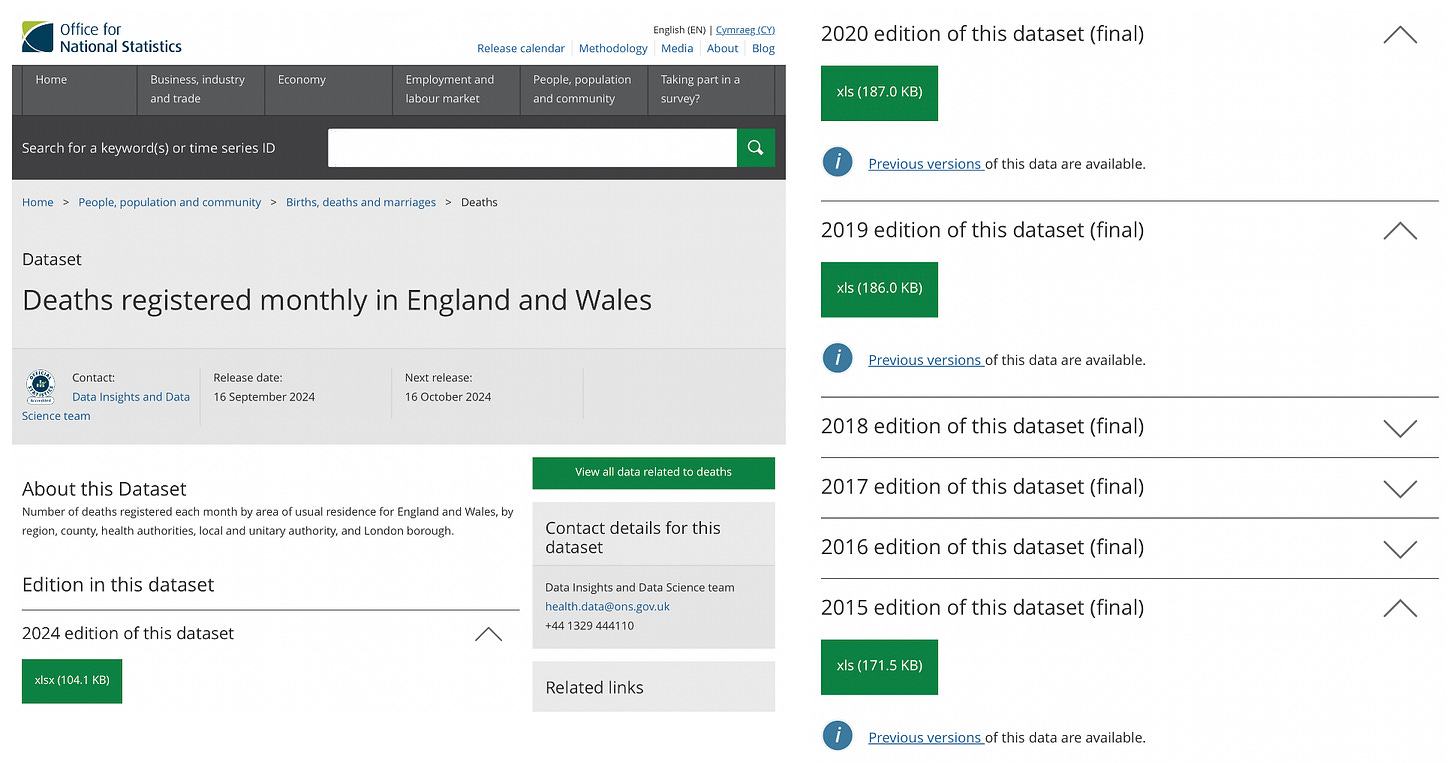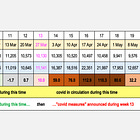Back to basics: a brief, sober and objective look at what was actually happening in early 2020
Some elementary figures, some important context and some basic questions
Dear Church Leaders (and everyone else)
When something unexpected and dramatic happens, it is sometimes difficult to think rationally about it at the time. It is only when the event has passed, and things are back to something like normal, that a sober and objective assessment can be made.
While writing another article, some basic questions occurred to me about early 2020. But before we get to them, some elementary figures and some important context…
Some elementary figures
Among many other things, the UK Office for National Statistics (ONS) produces data on the number of deaths registered monthly1 in England and Wales.
Here is the relevant ONS web page:
And here is what a typical table of data (in the form of an XL file) looks like:
Working on the assumption that these figures are correct — why wouldn’t they be? — I took the England and Wales data for the months January to June from 2015-2020, as highlighted in the above snapshot, and pasted it into the table below for easy reference:
And, as you can see, I have added:
an extra column: Jan-Mar total — the sum of the figures for Jan, Feb and Mar
an extra row: the 2015-2019 average2 for each month
We shall return to that table in due course.
Some important context
According to media reports, covid was circulating in the UK in January 2020.
Here is a timeline from The Guardian, noting that “two Covid cases [were] confirmed in the UK” on 31 January 2020:
Here is a report from The Times at the actual time:
And here is confirmation from the BBC, which is, as regular readers will be aware, part of the Orwellian-sounding Trusted News Initiative:
Some basic questions
Returning to the table, here are some obvious and fundamental questions:
February
If covid was:
circulating in the UK by the end of January
very infectious
significantly more deadly than any other respiratory virus in circulation
Why were there so few deaths registered in February 2020?
i.e. when people were living life normally, in schools and universities, in hospitals, in shops and businesses, in clubs, at sporting events, at cinemas and theatres, in pubs and restaurants, in places of worship etc.
Indeed assuming I have done the XL calculation correctly, deaths in England and Wales in February 2020 were 7% lower than the previous 5-year average, and lower than in any of the previous five years.
March
March is of course more complicated. It seems reasonable to assume there were some delays in death registrations after the first UK covid lockdown was announced on 23rd.
But there were no such complications in the first three weeks of March. And, thanks again to the ONS, we can drill down further.
This is a snapshot of the ONS weekly figures in March 2020 prior to lockdown:
Here are the numbers for the relevant weeks:
Week ending 06-Mar-2020: 10,895 deaths — 5% below the 5-year average
Week ending 13-Mar-2020: 11,019 deaths — 2% below the 5-year average
Week ending 20-Mar-2020: 10,645 deaths — 1% above the 5-year average, but, in terms of the absolute number, the least deadly week of the year
For those three weeks taken together, the total number of registered deaths (32,559) was 2% below the total of the numbers for the corresponding weeks in the 5-year average (33,276).
And yet it was in the context of the above figures that schools and universities were closed (to most students) and educational activities restricted, going to hospital was strongly discouraged, and “non-essential” shops and businesses were closed. Along with clubs, sports activities, cinemas and theatres, pubs and restaurants, places of worship etc.
With devastating consequences. Especially for children.
And this happened four days after government announced that “COVID-19 is no longer considered to be an HCID3 in the UK”:
The inconvenient truth is that the death rate began to mount only after the first lockdown was announced and the “covid response” started. When people panicked. When people were terrified by their governments. When people were told, “Don’t come into hospital if you can help it.”
And when “covid protocols”4 were adopted, including the administration of midazolam and the denial of antibiotics. For those “testing positive for covid” with a fraudulently-conducted test where, in the words5 of its Nobel Prize-winning inventor, “if you do it well, you can find almost anything in anybody”.
Which begs these questions (among many others):
What would have happened if there had been no media reports of covid?
And if governments had not implemented any “covid restrictions” at all, as had been the case during February and early March when deaths were at (or below) normal levels?
Other questions
I realise that some might disparage what I have done — i.e. taking literally a few minutes to go to the official government website and do a little reading — as “doing my own research” rather than trusting the “experts”. As if that were somehow a bad thing?!
Most people could do this. No expertise is required here. Anyone capable of passing GCSE Maths could have researched and written this article.
But in any case, the basic questions that I have raised remain.
As do plenty of others.
Not least:
Why are so few mainstream media journalists asking such questions?
And why, when most people are approached about such questions, do they simply not want to engage? Including my own church leaders, at least one of whom is more qualified than I am6 to answer questions about numerical matters.7
It is not only in Christ that God makes foolish the wisdom of the world.8
Update: for weekly data, see this post:
Not unrelated:
Dear Church Leaders articles (some of which, including this one, can also be found on Unexpected Turns)
The Big Reveal: Christianity carefully considered
NB these figures relate to the registration of deaths and, in the words of the ONS, “Bank Holidays could affect the number of registrations made within [the relevant] months.” So we may reasonably expect that some deaths in December over the Christmas-New Year period will be registered in January. And that in years such as 2016 and 2018 — when one or more of the Easter bank holidays falls in March — some deaths that would ordinarily be registered in March are not actually registered until April.
What statisticians call the “arithmetic mean”, as distinct from other types of average
HCID = high-consequence infectious disease
Such as the document NG163, COVID-19 rapid guideline: managing symptoms (including at the end of life) in the community, which is no longer available on the NICE website, but can be viewed e.g. here (archived version) or here (pdf, c/o this related article)
You might have to click twice on that link… and turn off the mute…
For the record, I am not without qualifications in maths
And in our congregation there is, I suspect, a greater number of highly-qualified mathematicians and statisticians than in most churches in the country















